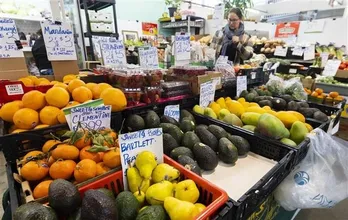
As of October 21 this year, market capitalisation of UPCoM reached 1.42 quadrillion VND (62.4 billion USD), an increase of nearly half compared to the beginning of the year. (Photo: thoibaokinhdoanh.vn)
As of October 21 this year, market capitalisation of UPCoM reached 1.42 quadrillion VND (62.4 billion USD), an increase of nearly half compared to the beginning of the year, more than three times higher than the Hanoi Stock Exchange (HNX) and equal to 26 percent of the Ho Chi Minh Stock Exchange (HOSE).
Of the 903 businesses trading on UPCoM, 23 have a market capitalisation of more than 10 trillion VND, with some stock codes having very high values such as the State-run Airports Corporation of Vietnam (ACV), Viettel Global Investment JSC (VGI) - a subsidiary of telecom giant Viettel Group, Masan Consumer Corporation (MCH) and Binh Son Refinery (BSR).
UPCoM recently has attracted strong cash flow, evidenced by the increase of UPCoM-Index and strong improvement in liquidity.
The UPCoM-Index reached 47.74 points at the end of April 2021, rising to 96.56 nearly 100 points by October 21. The five strongest gainers on the UPCOM in September were Cao Bang Sugar JSC (CBS), Hòa Bình Minerals Joint Stock Company (KHB), Viet Nhat Investment Corporation (VNH), PV - Inconess Investment Joint Stock Company (RGC) and Vinacomin - Pilot JSC (HTH), with increases of 113 to 158 percent.
Liquidity recorded growth month by month. In September alone, UPCoM had more than 2.4 billion shares transferred, up 12.7 percent, with a transaction value of 42.4 trillion VND, up 9.39 percent compared to August.
On average in September, the trading volume reached approximately 121.4 million shares per session, worth more than 2.1 trillion VND, up 24 percent and 20.3 percent, respectively compared to August.
In the last three months, Binh Son Refinery (BSR), Đèo Cả Traffic Infrastructure Investment JSC (HHV) and Vietnam National Textile & Garment Group (VGT) were named the top three most interesting stocks on UPCoM. In September, BSR had a trading volume of 216.6 million shares, HHV 154.8 million shares, and VGT 138.4 million shares. The next two were Viet Trung Nam Investment And Development JSC (VHG) and DAMAC GLS JSC (KSH), with a volume of 129.7 million shares and 112.7 million shares, respectively.
Not only has the trading volume of domestic investors increased, UPCoM is increasingly attracting the attention of foreign investors. In the third quarter of 2021, foreign investors net bought 613 billion VND. Particularly in September, foreign investors traded 45.2 million shares, equivalent to nearly 1.7 trillion VND, and net bought more than 378 billion VND.
The top five stocks bought most by foreign investors in September were Đèo Cả Traffic Infrastructure Investment JSC (HHV), Quang Ngai Sugar Joint Stock Company (QNS), Vietnam Engine and Agricultural Machinery Corporation (VEA), Airports Corporation Of VietNam (ACV), and Thinh Vuong Electric Construction Investment and Trading Joint Stock Company (TV6), with an equivalent trading volume reaching 5.4 million units, 5.2 million units, 3.9 million units, 2.2 million units and 1.5 million units, respectively.
According to the Hanoi Stock Exchange, the operator of UPCoM, the UPCoM market is the cradle to nurture and develop businesses, thereby helping them get used to trading.
HNX was focusing on researching the innovation of UPCoM to increase the attractiveness of the unlisted market segment, contributing to promoting the process of equitisation, divestment and transparency of market operations.
HNX has issued the regulation on organisation and management of the unlisted securities trading market, which updated new regulations on equitisation and sale of State capital by the book-building method.
"HNX will propose to widen the trading price band on UPCoM, and at the same time continue to promote support programmes and transparency for businesses," the HNX leader said.
Compared to the two listed exchanges of HoSE and HNX, UPCoM has larger trading price band, attracting investors. However, stocks on UPCoM are not allowed to trade on margin, daily liquidity is low, the number of frequently traded stocks is only about 20 percent.
However, many businesses are considered to have a stable business foundation and growth prospects.
A part of businesses on UPCoM are now qualified to list on HOSE or HNX, but still stay on this exchange because the ownership rate of public shareholders is low, while internal shareholders have no demand to switch floor. On the UPCoM, businesses are not under much pressure on information disclosure as well as other obligations as on HoSE and HNX./.
VNA
 Retailer brings Vietnamese products closer to consumers in Canada
Retailer brings Vietnamese products closer to consumers in Canada



